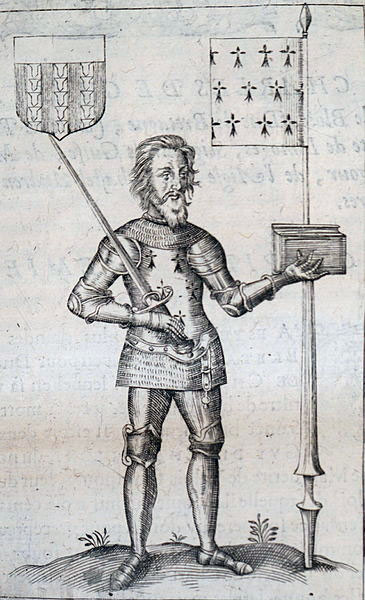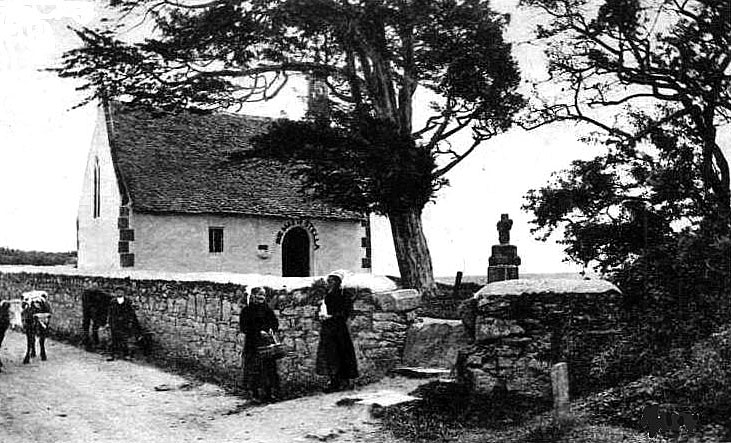The savage fight between the English force of Sir Thomas Dagworth and the Breton/French army of Charles of Blois outside the besieged Breton town of La Roche-Derrien on 20th June 1347 in the Hundred Years War
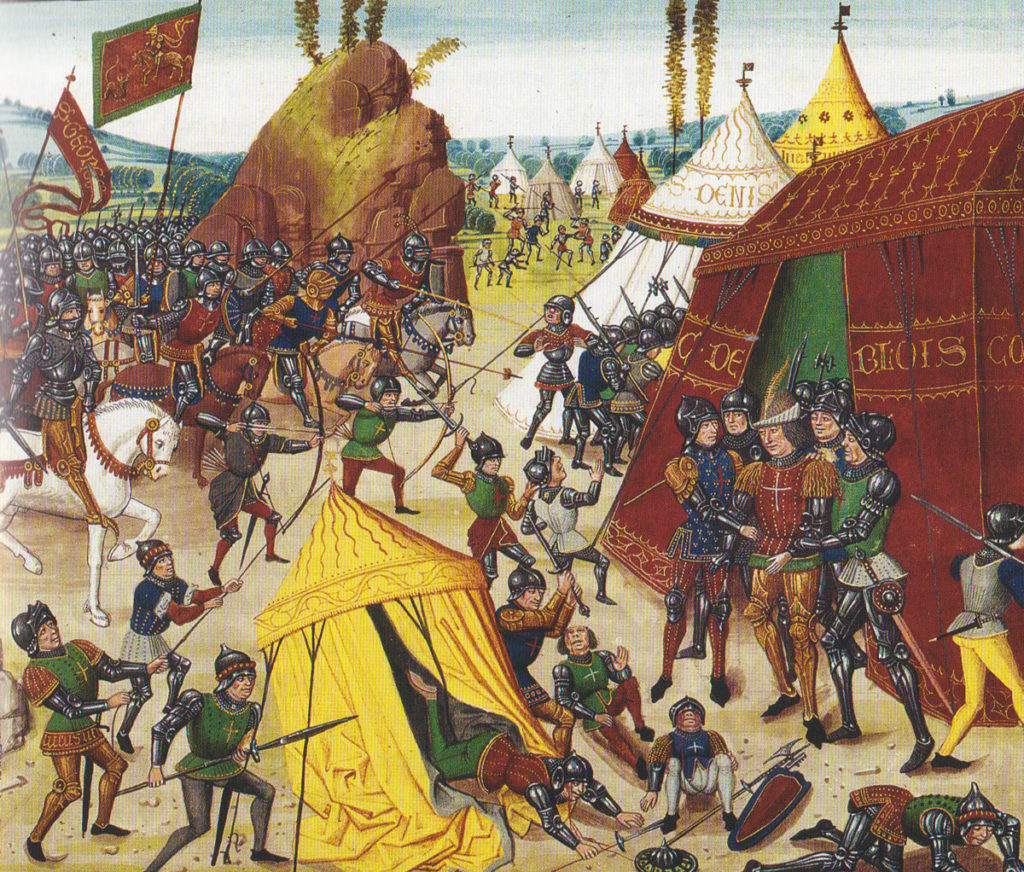
The previous battle of the Hundred Years War is the Battle of Neville’s Cross
The next battle of the Hundred Years War is the Battle of Winchelsea
Date of the Battle of La Roche-Derrien: 20th June 1347
Place of the Battle of La Roche-Derrien: in the North-West of Brittany in France.
Combatants at the Battle of La Roche-Derrien: An English force against a Breton/French army.
Commanders at the Battle of La Roche-Derrien: Sir Thomas Dagworth commanded the English force. Charles of Blois, claimant to the Duchy of Brittany, commanded the Breton/French army.
Size of the armies at the Battle of La Roche-Derrien: The English force comprised 300 men-at-arms and 400 archers. The army of Charles of Blois is said to have been many times larger. The English garrison in La Roche-Derrien numbered 250 men.
Winner of the Battle of La Roche-Derrien: Sir Thomas Dagworth’s force drove the Breton/French army from its lines outside La Roche-Derrien in headlong retreat, inflicting heavy casualties and lifting the siege of the English garrison.
Background to the Battle of La Roche-Derrien:
In April 1341 John, Duke of Brittany, died leaving no direct heir to this important dukedom situated in the north-west corner of France.
The two claimants to the dukedom were Charles, Count of Blois, married to the deceased duke’s niece, Joan of Ponthièvre and John de Montfort, the deceased duke’s step-brother by his father’s second wife, the widow of King Alexander II of Scotland.
Charles of Blois was the nephew of King Philip VI of France, who strongly supported his claim to the Duchy of Brittany.
The claim of John de Montfort was consequently supported by King Edward III of England.
The two parties began a war to take Brittany.
In November 1341, Charles of Blois with a strong Breton/French army captured the city of Nantes and with it John de Montfort, who was imprisoned in Paris.
The resistance on behalf of John de Montfort was continued by his wife, the redoubtable Joan of Flanders.
The first phase of the Breton War came to a close with the Truce of Malestroit in late 1343 and King Edward III returned to England with Joan of Flanders.
In May 1345 John de Montfort escaped from prison in Paris and arrived in England, where he did homage to King Edward III for the Duchy of Brittany.
In early June 1345 John de Montfort and the Earl of Northampton took an English army and fleet to Brittany, landing at Brest.
The rival claimant to the Duchy of Brittany, Charles of Blois, was conducting a successful campaign in southern Brittany in furtherance of his cause.
John de Montfort attempted to retake the city of Quimper in south-western Brittany, but Charles of Blois relieved the city before the siege could be brought to a successful conclusion.
John de Montfort died soon afterwards, leaving his claim to the Duchy to be pursued by King Edward III on behalf of his son, the six-year-old John de Montfort.
In early December 1343 the Earl of Northampton took the town of La Roche-Derrien on the northern coast of Brittany, with its neighbouring port of Tréguier after a three-day siege.
Northampton dispatched his lieutenant, Sir Thomas Dagworth, to take a number of other towns in northern Brittany.
Charles of Blois finally moved against Dagworth with his army in the early summer of 1346.
Battle of St Pol de Léon.
Charles of Blois’ army came up with Dagworth’s force on 9th June 1346 at St Pol de Léon, north-west of Morlaix.
Blois’ substantially larger Breton/French army attacked Dagworth’s small force. The first assault was repelled.
A second attack enveloped Dagworth’s line but was shot down by the English archers. Suffering heavy casualties, Blois’ army fled the battlefield.
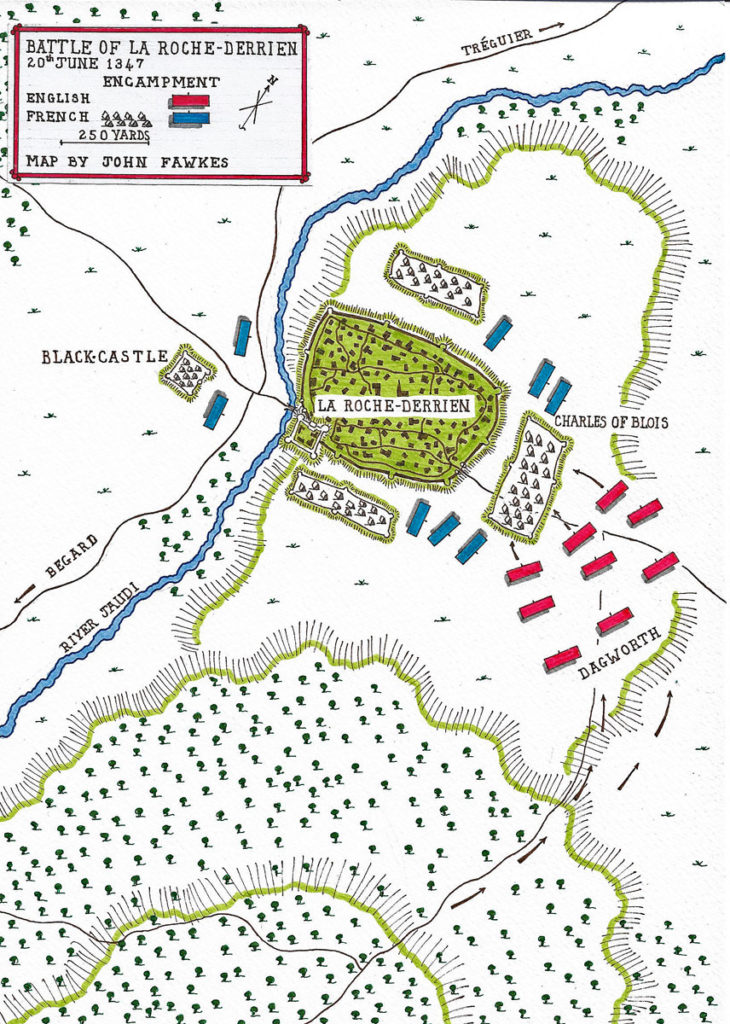
Battle of La Roche-Derrien:
After the disaster of St Pol de Léon, Charles of Blois spent a considerable time rebuilding his army.
In May 1347, Charles of Blois considered his army sufficiently large to begin the recovery of the Penthièvre in northern Brittany, an area that supported his claim to the Duchy of Brittany.
On 20th May 1347 Charles of Blois’ army reached La Roche-Derrien and began a siege of the town.
The attack on La Roche-Derrien was designed to lure the English commander, Sir Thomas Dagworth, into attempting a relief, so that Charles of Blois could meet him in battle and destroy his small army.
La Roche-Derrien stands on high ground on the east bank of the River Jaudi, with further higher ground to its south. The town castle overlooked the bridge that crossed the narrow river.
Charles of Blois’ army built extensive siege works including three fortified camps to the north, east and south of the town.
A large ancient earthwork on the far side of the river, known as ‘Black Castle’, was occupied by the besiegers.
The Breton/French army began a bombardment of the town with 9 catapults of various sizes, the largest being a machine that hurled stones of 300 lb in weight.
Much damage was inflicted, including the partial destruction of the governor’s house.
The English governor of La Roche-Derrien, Richard Totsham, although under pressure from various prominent inhabitants, including his wife, refused to surrender the town.
Sir Thomas Dagworth, drawing on the various English garrisons in western Brittany, assembled the largest force available to him at Carhaix, some 50 miles to the south-west of La Roche-Derrien.
Dagworth’s force, according to his report to King Edward III of the subsequent battle, comprised 300 men-at-arms and 400 archers, all mounted.
In his report on the battle, Dagworth gave the size of Charles of Blois’s force as 1,800 men-at-arms, 600 archers, 2,000 crossbowmen and an unknown number of variously armed peasant infantry.
Dagworth marched towards La Roche-Derrien and halted at a large monastery in Begard, 9 miles short of the besieged town.
The direct road from Begard to La Roche-Derrien lay along the west bank of the River Jaudi, reaching the town at the point where the bridge crossed the river under the eyes of the garrison of the ‘Black Castle’.
Dagworth chose to make his final approach to La Roche-Derrien during the night, along the east bank of the River Jaudi, while a diversionary party came up the road, making a considerable noise to distract the besiegers.
Charles of Blois had notice of Dagworth’s advance and prepared his troops, ordering the garrisons of each of the camps to stay put and await attack.
Expecting his force to reach the French encampment in the dark, Dagworth instructed his men with a sign and counter-sign to enable them to identify friend and foe in the impending night fighting.
Dagworth’s army moved out on its final approach march at midnight on 19th June 1347, directed by three guides.
The march went without mishap and Dagworth’s force came up to La Roche-Derrien before dawn on 20th June 1347.
The English force emerged from the woods and attacked the camp lying to the east of the town, occupied by Charles of Blois himself with the largest Breton/French/ force.
In heavy fighting the English made little progress and Dagworth was wounded and captured.
Dawn was now breaking and the English garrison could see what was going on in the Breton/French camps.
The governor of La Roche-Derrien, Richard Totsham, assembled his troops, less a small force to hold the walls against any surprise from across the river, marched out of the town and attacked the rear of Charles of Blois’ force.
This unexpected assault was sufficient to overwhelm the Breton/French in Charles of Blois’ camp, causing them to break away in flight.
Instructed not to leave their camps, the Breton/French troops in the other two camps were attacked in turn by the English and overwhelmed.
The troops in Black Castle, although hearing the sound of the frenzied combat on the far side of the river, did not intervene, in the light of their instructions not to leave their encampment, finally marching away to the east.
The most decisive feature of this remarkable battle was the fate of Charles of Blois. He emerged unarmoured from his tent at the onset of the English attack and suffered a number of wounds in the struggle, before being captured by the English.
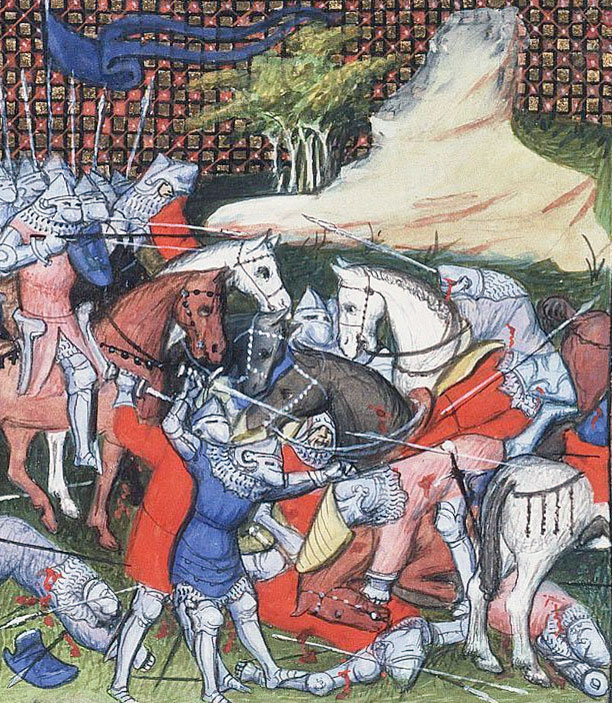
Casualties at the Battle of La Roche-Derrien: Breton/French casualties were high.
From the Breton noblemen of Charles of Blois’ party, the dead included the Vicomte de Rohan and the lords of Laval, Châteaubriand, Malestroit and Rougé.
Some 600 Breton/French men-at-arms and squires were killed.
English casualties were probably high as a proportion of their small numbers, but significantly less in total than the French.
The most important casualty of the battle was the wounding and capture of Charles of Blois, undermining his claim to the duchy and imposing a major handicap on the French conduct of the war.
Follow-up to the Battle of La Roche-Derrien: Charles of Blois is said to have suffered seventeen wounds. He was taken by Dagworth to a series of castles to recover from his injuries, before being conveyed to England and imprisoned for a number of years.
The battle deprived King Philip VI of France of his candidate for the duchy of Brittany.
Dagworth subsequently went to England and the French took advantage of his absence to surprise the town of La Roche-Derrien, storming it after a short siege of three days and slaughtering the inhabitants. The English garrison of 150 surrendered and was taken unarmed to Châteauneuf, where they were massacred by the ‘butchers and carpenters’ of the town.
Anecdotes and traditions from the Battle of La Roche-Derrien:
- On his journey as a prisoner to England it is said that Charles of Blois was serenaded by eight guitar players to fend off the effects of seasickness.
- Charles of Blois wore a tight-fitting quilted jacket known as a ‘pourpoint’. This garment became popular as a memorial to Charles.
- Charles of Blois was beatified in 1905. A chapel was built on the spot where he was said to have been captured at the Battle of La Roche-Derrien.
References for the Battle of La Roche-Derrien:
The Hundred Years War by Alfred H. Burne
Trial by Battle, Volume I of the four volume record of the Hundred Years War by Jonathan Sumption.
The Art of War in the Middle Ages Volume Two by Sir Charles Oman.
The Hundred Years War by Robin Neillands.
British Battles by Grant.
The previous battle of the Hundred Years War is the Battle of Neville’s Cross
The next battle of the Hundred Years War is the Battle of Winchelsea
